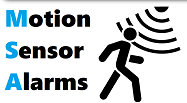Installing outdoor motion sensors seems like an obvious upgrade to your home’s security so that your perimeters are being monitored to alert you of any unwanted movement.
Installing indoor motion sensors can present you with a whole host of benefits too.
However, they come with their share of cons too. Let’s explore some of the benefits, drawbacks, and uses of indoor motion sensors.
Pros of Indoor Motion Sensors
How many times have you left a room and forgot to turn the light off? Indoor motion sensors can be set to control the lighting in your home to come on only when needed, and automatically turn off once you leave the area.
Indoor motion sensors can save you substantial amounts of electricity, making them the smart, economic choice. By having these installed, you ensure that you only use electricity when you need to.
The convenience of having lights turn on when you enter a room and not having to fumble around looking for a light switch goes without mentioning it. For some, it’s more than just a convenience. Having lights turn on automatically can eliminate accidents.
The most obvious benefit of indoor motion sensors, of course, is the added layer of security. They will detect any unwanted movement whatsoever, not just yours. Should your home’s outer perimeter be breached, indoor motion sensors can trigger an alarm and turn on lights.
Cons of Indoor Motion Sensors
Indoor motion sensors do provide a lot of convenience with additional security and a way to turn on lights when needed most, but on the other hand, there is the problem of a lack of control.
Motion sensors will come on with any movement that is detected, meaning that lights may be activated when you are merely passing by. Similarly, you may on occasion want to enter an area without turning on the lights. This can end up triggering many false alarms. For some people, indoor motion sensors can become intrusive and even disruptive due to unnecessary and unwanted activation.
This is, in fact, the reason why so many people with motion sensor lights also have additional lights that can be controlled manually.
How Do Motion Sensors Actually Work?
Motion sensors can either be active or passive.
Active Motion Sensors
Active motion sensors work by emitting an ultrasonic sound wave and have a wide array of uses residential as well as commercial. These are not very different from those used during pregnancies to view the developing baby. Waves that bounce back creates a pattern that continues until it is disrupted.
Once it picks up any change in the wave, the sensor is triggered to turn on the lights, open an automatic door, or even sound an alarm to warn you of any unlawful movement.
Passive Motion Sensors
Passive motion sensors are mostly found in residential homes. They work by measuring infrared (IR) light radiating from objects in their field of view.
Humans and animals emit infrared energy in the form of heat, making them susceptible to be picked up by these IR motion sensors.
All IR sensors have some common ratings and specifications in order for you to determine their detection pattern or the field of view.
This defines how wide or narrows the IR sensor can detect movement within its range.
Indoor Motion Sensors and Your Pets
Indoor motion sensor lights are great if you worry about your pets feeling abandoned. Instead of leaving your pets at home in the dark, these sensors will pick up on any movements and turn the lights on as soon as your dog or cat enters the room. This will make them feel less alone compared to sitting in a dark, empty house.
